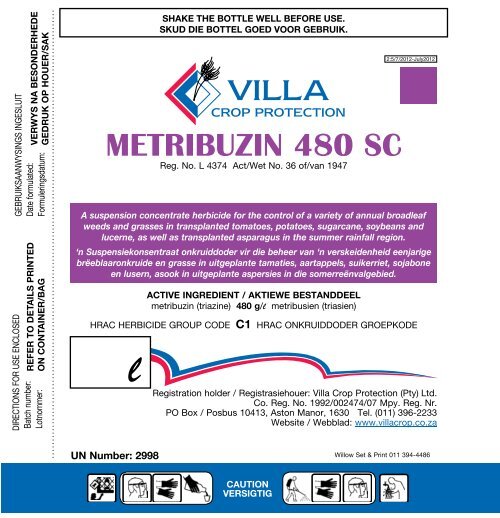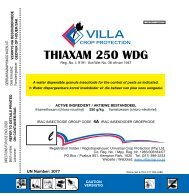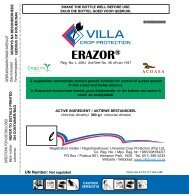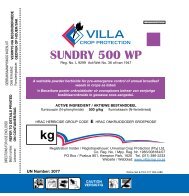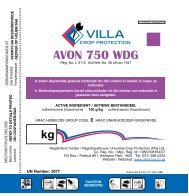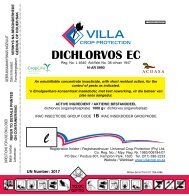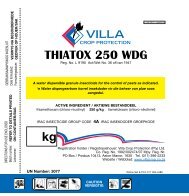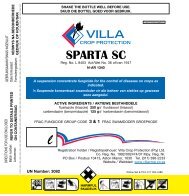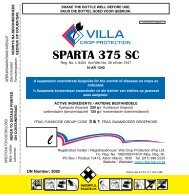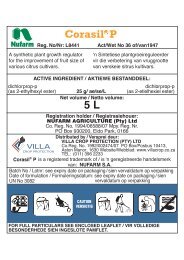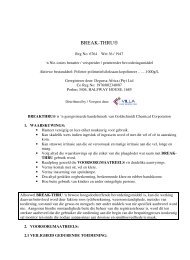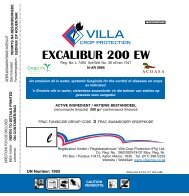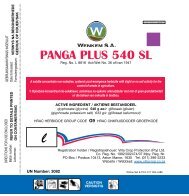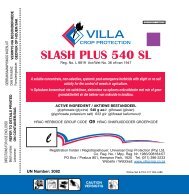Metribuzin 480 SC E_Villa
Metribuzin 480 SC E_Villa
Metribuzin 480 SC E_Villa
You also want an ePaper? Increase the reach of your titles
YUMPU automatically turns print PDFs into web optimized ePapers that Google loves.
GEBRUIKSAANWYSINGS INGESLUIT<br />
Date formulated:<br />
VERWYS NA BESONDERHEDE<br />
Formuleringsdatum:<br />
GEDRUK OP HOUER/SAK<br />
DIRECTIONS FOR USE ENCLOSED<br />
Batch number: REFER TO DETAILS PRINTED<br />
Lotnommer: ON CONTAINER/BAG<br />
METRIBUZIN <strong>480</strong> <strong>SC</strong><br />
Reg. No. L 4374 Act/Wet No. 36 of/van 1947<br />
A suspension concentrate herbicide for the control of a variety of annual broadleaf<br />
weeds and grasses in transplanted tomatoes, potatoes, sugarcane, soybeans and<br />
lucerne, as well as transplanted asparagus in the summer rainfall region.<br />
‘n Suspensiekonsentraat onkruiddoder vir die beheer van ‘n verskeidenheid eenjarige<br />
brëeblaaronkruide en grasse in uitgeplante tamaties, aartappels, suikerriet, sojabone<br />
en lusern, asook in uitgeplante aspersies in die somerreënvalgebied.<br />
l Registration<br />
UN Number: 2998<br />
SHAKE THE BOTTLE WELL BEFORE USE.<br />
SKUD DIE BOTTEL GOED VOOR GEBRUIK.<br />
ACTIVE INGREDIENT / AKTIEWE BESTANDDEEL<br />
metribuzin (triazine) <strong>480</strong> g/l metribusien (triasien)<br />
2:5/7/2012-July2012<br />
HRAC HERBICIDE GROUP CODE C1 HRAC ONKRUIDDODER GROEPKODE<br />
holder / Registrasiehouer: <strong>Villa</strong> Crop Protection (Pty) Ltd.<br />
Co. Reg. No. 1992/002474/07 Mpy. Reg. Nr.<br />
PO Box / Posbus 10413, Aston Manor, 1630 Tel. (011) 396-2233<br />
Website / Webblad: www.villacrop.co.za<br />
CAUTION<br />
VERSIGTIG<br />
Willow Set & Print 011 394-4486
METRIBUZIN <strong>480</strong> <strong>SC</strong><br />
Reg. No. L 4374 Act/Wet No. 36 op/van 1947<br />
HRAC HERBICIDE GROUP CODE / HRAC ONKRUIDDODER GROEPKODE: C1<br />
ACTIVE INGREDIENT / AKTIEWE BESTANDDEEL:<br />
metribuzin (triazine) / metribusien (triasien) ………………..………………………......................................<strong>480</strong> g/l<br />
Registration holder / Registrasiehouer:<br />
VILLA CROP PROTECTION (PTY) LTD.<br />
Co. Reg. No. 1992/002474/07 Mpy. Reg. Nr.<br />
P.O. Box / Posbus 10413, ASTON MANOR, 1630,<br />
Tel. (011) 396 2233<br />
CAUTION / VERSIGTIG<br />
2:5/7/2012 – July2012<br />
WARNINGS<br />
• Lucerne: Allow 25 days between the last application and harvest or grazing.<br />
• Store under lock and key in a cool, dry, well-ventilated place, away from food, feeds, seed, fertilizers and<br />
other agricultural remedies.<br />
• Keep out of reach of children, uninformed persons and animals.<br />
• In case of poisoning call a physician immediately and make this label available to him/her.<br />
Aerial application:<br />
Notify all inhabitants in the immediate vicinity of the area to be sprayed and issue the necessary warnings.<br />
Do not spray over or allow the drift to contaminate water or adjacent areas.<br />
Although this remedy has been extensively tested under a large variety of conditions, the<br />
registration holder does not warrant that it will be efficacious under all conditions. The action and<br />
effect thereof may be affected by factors such as abnormal soil, climatic and storage conditions,<br />
quality of dilution water, compatibility with other substances not indicated on the label, the<br />
occurrence of resistance of weeds against the remedy concerned, as well as by the method, time<br />
and accuracy of application. The registration holder furthermore does not accept responsibility<br />
for damage to crops, vegetation, the environment or harm to man or animal or for lack of<br />
performance of the remedy concerned, due to failure of the user to follow the label instructions or<br />
to the occurrence of conditions, which could not have been foreseen in terms of the registration.<br />
Consult the supplier in the event of any uncertainty.<br />
PRECAUTIONS<br />
• Avoid inhalation of the spray mist or fumes.<br />
• Avoid contact with skin and eyes.<br />
• Wear protective rubber gloves and a face shield when handling the concentrate.<br />
• Wash with soap and water after use and accidental skin contact.<br />
• Wash contaminated clothing after use.<br />
• In case of eye contamination, rinse the eyes thoroughly with plenty of clean water for at least 20 minutes,<br />
holding the eyelid(s) open. Obtain medical assistance immediately.<br />
• Do not eat, drink or smoke whilst mixing, applying or before washing hands and face or change of<br />
clothing.<br />
• Prevent drift onto other crops, grazing, rivers, dams or areas not under treatment or to nearby water<br />
sources.<br />
• Clean the applicator before using for other products and dispose of wash water where it will not<br />
contaminate food, grazing, rivers or dams.<br />
• TRIPLE RINSE empty containers in the following manner: Invert the empty container over the spray or<br />
mixing tank and allow draining for at least 30 seconds after the flow has slowed down to a drip.<br />
Thereafter rinse empty container three times with a volume of clean water equal to a minimum of 10 % of<br />
the container. Add the rinsing to the contents of the spray tank before destroying the container in the<br />
prescribed manner.<br />
• Destroy the empty container by perforation and flattening and dispose of it in a safe way.<br />
• Never re-use the empty container for any other purpose.<br />
• Prevent contamination of food, feeds, drinking water and eating utensils.<br />
METRIBUZIN <strong>480</strong> <strong>SC</strong> PAGE 2 OF 9
2:5/7/2012 – July2012<br />
RESISTANCE WARNING<br />
METRIBUZIN <strong>480</strong> <strong>SC</strong> is a group code C1 herbicide. Any weed population may contain individuals naturally<br />
resistant to METRIBUZIN <strong>480</strong> <strong>SC</strong> and other group code C1 herbicides. The resistant individuals can<br />
eventually dominate the weed population if these herbicides are used repeatedly. These resistant weeds<br />
may not be controlled by METRIBUZIN <strong>480</strong> <strong>SC</strong> or any other group code C1 herbicide.<br />
To delay herbicide resistance:<br />
• avoid exclusive repeated use of herbicides from the same herbicide group code. Alternate or tank<br />
mix with products from different herbicide group codes,<br />
• integrate other control methods (chemical, cultural, biological) into weed control programmes.<br />
For specific information on resistance management contact the registration holder of this product.<br />
USE RESTRICTIONS<br />
• Do not plant crops other than potatoes and sugarcane within six (6) months of a METRIBUZIN <strong>480</strong> <strong>SC</strong><br />
application. Crops such as maize, carrots, tomatoes, beetroot, asparagus, turnips and soybeans may be<br />
planted six (6) months after a METRIBUZIN <strong>480</strong> <strong>SC</strong> application, while twelve (12) months should elapse<br />
before crops such as brassicae, cucurbits, onions, peas, beans, wheat, lettuce, tobacco and strawberries<br />
are planted. However, when METRIBUZIN <strong>480</strong> <strong>SC</strong> plus Lasso EC were applied to soybeans as<br />
recommended (refer “REMARKS”: Soybeans), the crops mentioned above may be planted after half the<br />
waiting period indicated has elapsed. In case of a soybean crop failure (e.g. due to severe hail damage),<br />
soybeans may be replanted immediately in the following manner:<br />
The soil should not be disturbed (disked or ploughed) but the new soybean crop should be planted as<br />
deep as possible. A residual herbicide should not be applied, but if needed, a post-emergence herbicide<br />
may be applied.<br />
• Prior to the planting of subsequent crops, deep and thorough ploughing (not less than 20 cm) with a<br />
mould board or disc plough is essential.<br />
• Do not apply METRIBUZIN <strong>480</strong> <strong>SC</strong> to winter-grown potatoes or in areas where untimely frost occurs. Do<br />
not apply METRIBUZIN <strong>480</strong> <strong>SC</strong> to potatoes during the months April to September. Cold spells after early<br />
spring application of METRIBUZIN <strong>480</strong> <strong>SC</strong> may cause stunting of potatoes. Differences in cultivar<br />
sensitivity may occur. It has been found that under unfavourable conditions the cultivars BP1, Koos Smit,<br />
Astrid, Late Harvest and Earliest of All are more prone to damage, than others.<br />
• The use of poor quality, diseased seeds or seedlings may lead to METRIBUZIN <strong>480</strong> <strong>SC</strong> damage. In the<br />
case of potatoes it has been found that plants from seed of 60 g and smaller are more prone to damage.<br />
Potatoes: Too early ridging or disturbance of the soil after application may result in shifting or concentrating<br />
the herbicide over the plant row with a possibility of subsequent phytotoxicity. A period of at least six (6)<br />
weeks should elapse from application time to ridging. Avoid excessive overlapping of spray swaths and<br />
double spraying. Over-application, applying at the incorrect growth stage or any other use not in accordance<br />
with the directions on this label, may cause stunting of crops and other effects.<br />
Soybeans: Not recommended for use on the cultivars Edgar, Dumela, Ibis, Highveld Top and Komati. Do<br />
not apply METRIBUZIN <strong>480</strong> <strong>SC</strong> for multiplication of mother seed or on any soybean cultivars on which<br />
METRIBUZIN <strong>480</strong> <strong>SC</strong> has not been tested, before consulting the supplier. Do not apply METRIBUZIN <strong>480</strong><br />
<strong>SC</strong> to soybeans grown in soil with excessively low or high pH values (below 4.5 or above pH 7.0), as injury to<br />
soybeans may occur, or in soil with mineral deficiencies or where water logging occurs.<br />
Lucerne: Apply METRIBUZIN <strong>480</strong> <strong>SC</strong> only to established lucerne, which has completed at least one full<br />
growing season. Apply after cutting or grazing prior to the emergence of the weeds. Chlorosis of the lucerne<br />
plants may occur, but should disappear after a short while without affecting the yield. Do not apply<br />
METRIBUZIN <strong>480</strong> <strong>SC</strong> to lucerne, grown in soil with excessively high pH values (pH > 7.0), soil with mineral<br />
deficiencies or where water logging occurs as this may aggravate chlorosis. Use only on the following<br />
cultivars: CUF 101, SA Standard and Granada.<br />
SPRAYING CONDITIONS<br />
• Best results are obtained when METRIBUZIN <strong>480</strong> <strong>SC</strong> is applied to moist soil, free of clods and in a fine<br />
tilth, before weeds are emerged or at the latest when broad-leaved weeds (dicotyledons) are young (4- to<br />
6-leaf stage) and grasses (monocotyledons) are not bigger than 3-leaf stage and all actively growing.<br />
• Climatic conditions ideally should be warm and optimal for plant growth.<br />
• METRIBUZIN <strong>480</strong> <strong>SC</strong> should normally control weeds for a period of 8 to 16 weeks. However, this is<br />
dependent on factors such as soil type, rate of application as well as organic matter content, silt fraction,<br />
soil pH and climatic conditions after application.<br />
METRIBUZIN <strong>480</strong> <strong>SC</strong> PAGE 3 OF 9
2:5/7/2012 – July2012<br />
NOTE<br />
• Climatic conditions affect the efficacy of, as well as crop tolerance to, METRIBUZIN <strong>480</strong> <strong>SC</strong>. Prior to a<br />
METRIBUZIN <strong>480</strong> <strong>SC</strong> application, the following should be considered:<br />
Should circumstances necessitate that a METRIBUZIN <strong>480</strong> <strong>SC</strong> treated land be re-planted to an<br />
alternative crop, refer to “USE RESTRICTIONS”.<br />
• Tomato and asparagus transplants should have taken root, before METRIBUZIN <strong>480</strong> <strong>SC</strong> application.<br />
METRIBUZIN <strong>480</strong> <strong>SC</strong> will adversely affect newly planted, interplanted and weak tomato and asparagus<br />
plants. At least two (2) days of sunny weather should precede METRIBUZIN <strong>480</strong> <strong>SC</strong> application on<br />
tomatoes.<br />
• Heavy rains following application will cause leaching of the product and a decrease in efficacy. Plant<br />
residues or stubble (mulch) covering the soil, will also adversely affect the efficacy of METRIBUZIN <strong>480</strong><br />
<strong>SC</strong>.<br />
• Do not add any wetting agents, fertilizers or other spray materials, except those mentioned on this label,<br />
to METRIBUZIN <strong>480</strong> <strong>SC</strong> spray mixtures.<br />
DIRECTIONS FOR USE: Use only as directed.<br />
Compatibility:<br />
• METRIBUZIN <strong>480</strong> <strong>SC</strong> is normally compatible with AMETRYN 500 <strong>SC</strong> (L 7742), DIURON 800 <strong>SC</strong> (L<br />
3200), DIURON 800 WP (L 3227), GESAPAX 500 <strong>SC</strong> (L 2784), LASSO EC (L 0977) and SKOFFEL ®<br />
145 SL (L 4347).<br />
• Strictly adhere to mixing instructions and all label recommendations of products, which are to be mixed<br />
with METRIBUZIN <strong>480</strong> <strong>SC</strong>.<br />
• Prior to mixing in a tank, a compatibility test should be carried out to determine if quality of water does<br />
not affect compatibility.<br />
• When METRIBUZIN <strong>480</strong> <strong>SC</strong> is used in conjunction with any other agricultural remedy, all WARNINGS,<br />
PRECAUTIONS and DIRECTIONS FOR USE mentioned on that label, must be adhered to.<br />
Mixing instructions:<br />
• Half fill the spray tank with clean water.<br />
• Add the required amount of METRIBUZIN <strong>480</strong> <strong>SC</strong> to the tank while agitating.<br />
• Fill the spray tank with water to the required level.<br />
• Prepared spray mixtures must not be left in the spray tank for any length of time, e.g. overnight.<br />
APPLICATION<br />
Ground application:<br />
Apply by means of a tractor-mounted boom sprayer or other suitable ground spraying equipment, which is<br />
correctly calibrated to deliver at least 200 litres spray mixture per hectare, at a constant speed and pressure<br />
of 200 to 300 kPa, to ensure even delivery. Avoid overlapping of swaths and close the nozzles while starting<br />
slow movement, turning and stopping to prevent over-application.<br />
Aerial application:<br />
Aerial application of METRIBUZIN <strong>480</strong> <strong>SC</strong> may only be performed by a registered aerial application operator<br />
using a correctly calibrated, registered aircraft according to the instructions of SANS Code 10118 (Aerial<br />
Application of Agricultural Pesticides). Ensure that the spray mixture is distributed evenly over the target<br />
area and that the loss of spray material during application is restricted to a minimum. It is therefore essential<br />
that the following criteria be met:<br />
• Volume: Pre-emergence - 30 litres per hectare. Post-emergence – 30 to 35 litres per hectare. As this<br />
product has not been evaluated at a reduced volume rate, the registration holder cannot guarantee<br />
efficacy, or be held responsible for any adverse effects if this product is applied aerially at a lower volume<br />
rate than recommended above.<br />
• Droplet coverage: The following number of droplets per cm 2 must be recovered at the target area: Preemergence<br />
- 20 to 30. Post-emergence - 35 to 45.<br />
• Droplet size: The following droplet spectra are recommended: Pre-emergence- VMD of 350 to 400<br />
micron. Post-emergence - VMD of 300 to 350 micron. Limit the production of fine droplets less than 150<br />
micron (high drift and evaporation potential) to a minimum.<br />
• Flying height: Maintain the height of the spray boom at 3 to 4 metres above the target. Do not spray<br />
when aircraft dives, is in a climb or when banking.<br />
METRIBUZIN <strong>480</strong> <strong>SC</strong> PAGE 4 OF 9
2:5/7/2012 – July2012<br />
• Use suitable atomising equipment that will produce the desired droplet size and coverage, but which will<br />
ensure the minimum loss of product. The spraying system must produce a droplet spectrum with the<br />
lowest possible Relative Span.<br />
• Position all the atomisers within the inner 60 to 75 % of the wingspan to prevent droplets from entering<br />
the wingtip vortices.<br />
• The difference in temperature between the wet and dry bulb thermometers, of a whirling hygrometer,<br />
should not exceed 8°C.<br />
• Stop spraying if the wind speed exceeds 15 km per hour.<br />
• Stop spraying under turbulent, unstable and dry conditions during the heat of the day.<br />
• Spraying under temperature inversion conditions (spraying in or above the inversion layer) and/or high<br />
humidity conditions (relative humidity 80 % and above) may lead to the following:<br />
a) reduced efficacy due to suspension and evaporation of small droplets in the air (inadequate<br />
coverage),<br />
b) damage to other sensitive crops and/or non-target areas through drifting of the suspended spray<br />
cloud away from the target field.<br />
• Ensure that the aerial spray operator knows exactly which fields to spray.<br />
Obtain an assurance from the aerial spray operator that the above requirements will be met and that relevant<br />
data will be compiled in a logbook and kept for future reference.<br />
METRIBUZIN <strong>480</strong> <strong>SC</strong> PAGE 5 OF 9
Broadleaf weeds controlled by METRIBUZIN <strong>480</strong> <strong>SC</strong>:<br />
Botanical name Common name<br />
Acalypha ecklonii<br />
Acanthospermum hispidum** Upright starbur<br />
Ageratum conyzoides Blue weed<br />
Amaranthus deflexus Perenial pigweed<br />
Amaranthus hybridus** Common pigweed<br />
Amaranthus spinosus Thorny pigweed<br />
Amaranthus thunbergii Red pigweed<br />
Ambrosia maritima Ragweed<br />
Anthemis cotula Stinking mayweed<br />
Argemone mexicana Mexican prickly poppy<br />
Bidens pilosa Blackjack<br />
Borreira natalensis Button weed<br />
Cenia turbinata Daisy<br />
Chenopodium album** White goosefoot<br />
Chenopodium carinatum Green goosefoot<br />
Chenopodium murale Nettle-leaved goosefoot<br />
Cirsium vulgare Scotch thistle<br />
Cleome monophylla Spindlepod<br />
Commelina benghalensis Benghal wandering Jew<br />
Conyza canadensis Horseweed fleabane<br />
Datura ferox Large thornapple<br />
Datura stramonium Thorn apple<br />
Emex australis Spiny emex<br />
Fumaria muralis Fumitory<br />
Euphorbia spp. Milkweed<br />
Galinsoga parviflora** Gallant soldier<br />
Gnaphalium luteo-album Jersey cudweed<br />
Hibiscus trionum Bladderweed<br />
Leucas martinicensis Bobbinweed<br />
Nicandra physalodes Apple-of-Peru<br />
Physalis angulata** Wild gooseberry<br />
Polygonum aviculare Prostrate knotweed<br />
Portulaca oleraceae** Common purslane<br />
Raphanus raphanistrum Wild radish<br />
Richardia brasiliensis Tropical richardia<br />
Schkuhria pinnata** Dwarf marigold<br />
Siegesbeckia orientalis Common St Paul’s Wort<br />
Solanum retroflexum Black nightshade<br />
Spergula arvensis Corn spurry<br />
Stellaria media Chickweed<br />
Tagetes minuta** Khakhi weed<br />
Tribulus terrestris Dubbeltjie<br />
Urtica urens Small stinging nettle<br />
Xanthium spinosum Spiny cocklebur<br />
Xanthium strumarium Cocklebur<br />
2:5/7/2012 – July2012<br />
METRIBUZIN <strong>480</strong> <strong>SC</strong> PAGE 6 OF 9
Grasses controlled by METRIBUZIN <strong>480</strong> <strong>SC</strong>:<br />
Botanical name Common name<br />
Chloris virgata Feather-top chloris<br />
Digitaria sanguinalis** Crab fingergrass<br />
Echinochloa crusgali Barnyard grass<br />
Erharta brevifolia<br />
Eleusine indica** Goose grass<br />
Eragrostis spp. Love grass<br />
Panicum coloratum Small buffalo grass<br />
Panicum maximum* Common buffalo grass<br />
Panicum schinzii Sweet buffalo grass<br />
Setaria verticillata Burr bristle grass<br />
Tragus racemosus Large carrot-seed grass<br />
Urochloa panicoides Herringbone grass<br />
Cyperus esculentus* Yellow nutsedge<br />
Mariscus macer*<br />
2:5/7/2012 – July2012<br />
• Refer remarks under "APPLICATION RATES".<br />
• * - Require 4.3 litres of METRIBUZIN <strong>480</strong> <strong>SC</strong> per hectare for adequate control. Cyperus rotundus and<br />
Solanum nigrum are normally not controlled with METRIBUZIN <strong>480</strong> <strong>SC</strong>.<br />
• ** - Weeds known to be susceptible to METRIBUZIN <strong>480</strong> <strong>SC</strong> plus Lasso EC mixture in soybeans (refer<br />
Lasso EC label).<br />
APPLICATION RATES<br />
Crop and Soil type Rate (l / ha) Remarks<br />
Asparagus<br />
Established crop in<br />
the summer rainfall<br />
region only<br />
> 10 % clay<br />
Lucerne<br />
Established crop<br />
0 to 10 % clay<br />
(light sand to sand)<br />
11 to 20 % clay<br />
(loamy sand to<br />
sandy loam)<br />
21 to 35 % clay<br />
(sandy clay loam)<br />
1.5<br />
OR<br />
1.5<br />
PLUS<br />
2.0 kg<br />
Diuron 800 WP<br />
1.1<br />
1.5<br />
1.8 to 2.2<br />
Apply as a full cover spray to well-established<br />
transplants/crowns or on an established crop grown by<br />
direct seeding (sown at least one year prior to the<br />
METRIBUZIN <strong>480</strong> <strong>SC</strong> treatment). Mechanical cultivation to<br />
eradicate the existing weed population should precede the<br />
application of METRIBUZIN <strong>480</strong> <strong>SC</strong> or the METRIBUZIN<br />
<strong>480</strong> <strong>SC</strong>/Diuron 800 WP tank mixture. If the plants/crowns<br />
are transplanted in autumn, the herbicide must be applied<br />
in the following spring for maximum residual values. Not to<br />
be used on soil where the clay content is less than 10 %.<br />
Weeds: Pre-emergence.<br />
Apply as a full cover spray just prior to weed emergence to<br />
established, dormant lucerne that has completed a full<br />
growth season. Do not apply METRIBUZIN <strong>480</strong> <strong>SC</strong> to soils<br />
with high pH values (pH > 7), on soils with nutrient<br />
deficiencies or under waterlogged conditions. Use only on<br />
the cultivars CUF 101, SA Standard and Granada.<br />
Soybeans Not recommended on soils containing less than 10 % clay, or more than 35 % clay.<br />
11 to 20 % clay 0.6<br />
PLUS<br />
5 l Lasso EC<br />
21 to 35 % clay 0.7<br />
PLUS<br />
5 l Lasso EC<br />
Apply evenly to the soil as a post-plant, pre-emergence<br />
application.<br />
Avoid overlapping of spray swaths.<br />
METRIBUZIN <strong>480</strong> <strong>SC</strong> PAGE 7 OF 9
Crop and Soil type RATE (l / ha) Remarks<br />
Sugarcane<br />
Not recommended on weak soils containing less than 6 % clay.<br />
Pre-emergence:<br />
6 to 20 % clay<br />
(light sand to sandy<br />
loam)<br />
21 to 35 % clay<br />
(loam to sandy clay<br />
loam)<br />
Early postemergence:<br />
6 to 20 % clay<br />
(light sand to sandy<br />
loam)<br />
21 to 35 % clay<br />
(loam to sandy<br />
loam)<br />
Aerial application:<br />
Early postemergence:<br />
6 to 35 % clay<br />
(light sand to sandy<br />
clay loam)<br />
Tomatoes<br />
(Transplanted)<br />
Post-transplanted:<br />
0 to 10 % clay<br />
(light sandy to<br />
sandy)<br />
11 to 20 % clay<br />
(loamy sand to<br />
sandy clay)<br />
21 to 35 %<br />
(sandy clay loam)<br />
2:5/7/2012 – July2012<br />
3.6 to 4.3<br />
OR<br />
2.0 to 2.9<br />
PLUS<br />
2.0 l Diuron 800 <strong>SC</strong> Apply uniformly to moist soil surface after planting or<br />
4.3<br />
OR<br />
2.5 to 2.9<br />
PLUS<br />
2.0 l Diuron 800 <strong>SC</strong><br />
3.6 to 4.3<br />
OR<br />
2.0 to 2.9<br />
PLUS<br />
2.0 l Diuron 800 <strong>SC</strong><br />
OR<br />
2.0 to 2.9<br />
PLUS<br />
3.0 to 4.0 l<br />
Ametryn 500 <strong>SC</strong><br />
4.3<br />
OR<br />
2.5 to 2.9<br />
PLUS<br />
2.0 l Diuron 800 <strong>SC</strong><br />
OR<br />
2.5 to 2.9<br />
PLUS<br />
3.0 to 4.0 l<br />
Ametryn 500 <strong>SC</strong><br />
3.6<br />
PLUS<br />
2.5 l<br />
Diuron 800 <strong>SC</strong><br />
1.1<br />
1.5<br />
harvesting.<br />
The high rates will have a suppressing effect on Cyperus<br />
esculentus.<br />
If Panicum maximum is present, the application should<br />
be performed pre-emergence (or very early postemergence).<br />
Apply before the grass weeds, especially Panicum<br />
maximum, are in the 2- to 3-leaf stage and broadleaf<br />
weeds are in the 4- to 6-leaf stage.<br />
Apply the high rates when Cyperus esculentus is<br />
present.<br />
The addition of Skoffel ® 145 SL as recommended in<br />
plant cane to METRIBUZIN <strong>480</strong> <strong>SC</strong> plus Diuron 800 <strong>SC</strong><br />
or to METRIBUZIN <strong>480</strong> <strong>SC</strong> plus Ametryn 500 <strong>SC</strong> will<br />
enhance the efficacy, particularly where Panicum<br />
maximum is a problem or has developed beyond the 3leaf<br />
stage, but is still in a stage prior to tillering.<br />
Apply uniformly in 30 to 40 litres spray solution per<br />
hectare.<br />
Refer to "REMARKS" above: Early post-emergence.<br />
Apply uniformly to the soil. Weeds should not be taller<br />
than 3 to 5 cm, grasses preferably at emergence.<br />
Tomato plants should have taken root, i.e. at least 14<br />
days after transplanting.<br />
METRIBUZIN <strong>480</strong> <strong>SC</strong> should be applied as a directed<br />
spray between the rows of tomatoes.<br />
1.8 to 2.2 Apply the high rate with higher clay fraction.<br />
METRIBUZIN <strong>480</strong> <strong>SC</strong> PAGE 8 OF 9
Crop and Soil type RATE (l / ha) Remarks<br />
Potatoes<br />
Pre-emergence:<br />
0 to 10 % clay<br />
(light sandy to<br />
sandy)<br />
11 to 20 % clay<br />
(loamy sand to<br />
sandy clay)<br />
21 to 35 %<br />
(sandy clay loam)<br />
METRIBUZIN <strong>480</strong><br />
<strong>SC</strong> + Lasso EC<br />
(Tank mixture)<br />
Early postemergence:<br />
METRIBUZIN <strong>480</strong><br />
<strong>SC</strong> + Skoffel ® 145<br />
SL<br />
(Tank mixture)<br />
Aerial application:<br />
0 to 10 % clay<br />
(light sandy to<br />
sandy)<br />
11 to 20 % clay<br />
(loamy sand to<br />
sandy clay)<br />
21 to 35 %<br />
(sandy clay loam)<br />
METRIBUZIN <strong>480</strong><br />
<strong>SC</strong> + Lasso EC<br />
(Tank mixture)<br />
1.1<br />
1.5<br />
1.8 to 2.2<br />
1.5<br />
1.8<br />
2.2 to 2.6<br />
2:5/7/2012 – July2012<br />
Apply uniformly to the soil from directly after planting<br />
until just before emergence of the potatoes.<br />
Apply the high rate with higher clay fraction.<br />
Lasso EC may be added at 5 litres per hectare (all soil<br />
types) to METRIBUZIN <strong>480</strong> <strong>SC</strong> (tank mixture). The<br />
METRIBUZIN <strong>480</strong> <strong>SC</strong> rate may be reduced by 0.36<br />
litres per hectare on soil with a clay content of up to 20<br />
%. The METRIBUZIN <strong>480</strong> <strong>SC</strong> rate remains as stated on<br />
soils with 21 to 35 % clay.<br />
Skoffel ® 145 SL may be added at 2 litres per hectare<br />
(all soil types) to METRIBUZIN <strong>480</strong> <strong>SC</strong>.<br />
METRIBUZIN <strong>480</strong> <strong>SC</strong> rate as stated according to soil<br />
type for potatoes. This tank mixture must be applied<br />
before 10 % emergence of the potato crop.<br />
Apply uniformly to the soil in 30 to 40 litres spray<br />
solution per hectare before emergence of potatoes.<br />
Apply the high rate with higher clay fraction.<br />
Lasso EC may be added at 5 litres per hectare (all soil<br />
types) to METRIBUZIN <strong>480</strong> <strong>SC</strong> (tank mixture).<br />
METRIBUZIN <strong>480</strong> <strong>SC</strong> rate in the tank mix should be as<br />
for ground application as listed for the different soil<br />
types.<br />
LASSO EC is a registered trademark of / is ‘n geregistreerde handelsmerk van<br />
Monsanto South Africa (Pty) Ltd.<br />
GESAPAX 500 <strong>SC</strong> is a registered trademark of / is ‘n geregistreerde handelsmerk van<br />
Syngenta SA (Pty) Ltd.<br />
DIURON 800 <strong>SC</strong> is a registered product of / is ‘n geregistreerde produk van<br />
Dow AgroSciences Southern Africa (Pty) Ltd.<br />
DIURON 800 WP is a registered product of / is ‘n geregistreerde produk van<br />
Dow AgroSciences Southern Africa (Pty) Ltd.<br />
SKOFFEL ® 145 SL is a registered trademark of / is ‘n geregistreerde handelsmerk van<br />
Universal Crop Protection (Pty) Ltd.<br />
AMETRYN 500 <strong>SC</strong> is a registered product of / is ‘n geregistreerde produk van<br />
<strong>Villa</strong> Crop Protection (Pty) Ltd.<br />
METRIBUZIN <strong>480</strong> <strong>SC</strong> PAGE 9 OF 9


